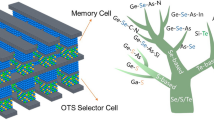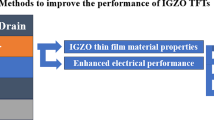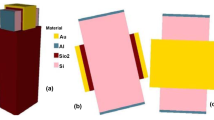Abstract
A comprehensive study of the drain current drift mechanism and hysteresis phenomena in fabricated p-channel junctionless ion-sensitive field-effect transistor (JL-ISFET) has been investigated for the first time. The current drift measurements have been performed through transient analysis of drain current, under different pH and liquid-gate bias (Vlg). Further, time-dependent gate-capacitance (CG) has also been analyzed to see the effect of hydroxyl ions (OH−) in the sensing film (Al2O3). The hysteresis has also been investigated for different pH loop (7 → 3 → 7 → 11 → 7 and 7 → 11 → 7 → 3 → 7) and times (960s, 1500s, and 1920s). It has been observed that the drift of JL-ISFET occurs because of chemical modification of the sensing film, due to OH−. The proposed device exhibits a threshold voltage sensitivity of 58.2 mV/pH that is near the Nernstian limit. Further, the hysteresis width and maximum drain current drift are measured as \(\sim \) 1.3 mV and 2.4 μ A (\(\sim \) 75%), respectively.
Similar content being viewed by others
References
Mani V, Devadas B, Chen S-M (2013) Direct electrochemistry of glucose oxidase at electrochemically reduced graphene oxide-multiwalled carbon nanotubes hybrid material modified electrode for glucose biosensor. Biosens Bioelectron 41:309–315
Sage AT, Besant JD, Lam B, Sargent EH, Kelley SO (2014) Ultrasensitive electrochemical biomolecular detection using nanostructured microelectrodes. Accounts of Chemical Research 47(8):2417–2425
Zhu C, Zeng Z, Li H, Li F, Fan C, Zhang H (2013) Single-layer mos2-based nanoprobes for homogeneous detection of biomolecules. J Am Chem Soc 135(16):5998–6001
Chartuprayoon N, Zhang M, Bosze W, Choa Y-H, Myung NV (2015) One-dimensional nanostructures based bio-detection. Biosens Bioelectron 63:432–443
Lee W-Y, Kim S-R, Kim T-H, Lee KS, Shin M-C, Park J-K (2000) Sol–gel-derived thick-film conductometric biosensor for urea determination in serum. Anal Chim Acta 404(2):195–203
Ahn J-H, Kim J-Y, Seol M-L, Baek DJ, Guo Z, Kim C-H, Choi S-J, Choi Y-K (2013) A ph sensor with a double-gate silicon nanowire field-effect transistor. Appl Phys Lett 102(8):083701
Gao A, Lu N, Dai P, Li T, Pei H, Gao X, Gong Y, Wang Y, Fan C (2011) Silicon-nanowire-based cmos-compatible field-effect transistor nanosensors for ultrasensitive electrical detection of nucleic acids. Nano Letters 11(9):3974–3978
Patolsky F, Zheng G, Lieber CM (2006) Fabrication of silicon nanowire devices for ultrasensitive, label-free, real-time detection of biological and chemical species. Nature Protocols 1(4):1711
Kim SJ, Jung J, Lee KW, Yoon DH, Jung TS, Dugasani SR, Park SH, Kim HJ (2013) Low-cost label-free electrical detection of artificial dna nanostructures using solution-processed oxide thin-film transistors. ACS Applied Materials & Interfaces 5(21):10715–10720
Huang ZJ Real-time profitability of published anomalies: An out-of-sample test, Available at SSRN 1364813
Colinge J-P, Lee C-W, Afzalian A, Akhavan ND, Yan R, Ferain I, Razavi P, O’neill B, Blake A, White M et al (2010) Nanowire transistors without junctions. Nature Nanotechnology 5(3):225–229
Sahu C, Singh J (2014) Charge-plasma based process variation immune junctionless transistor. IEEE Electron Device Letters 35(3):411–413
Narang R, Saxena M, Gupta M (2017) Analytical model of ph sensing characteristics of junctionless silicon on insulator isfet. IEEE Transactions on Electron Devices 64(4):1742–1750
Shafi N, Sahu C, Periasamy C (2019) Fabrication and ph sensitivity analysis of in-situ doped polycrystalline silicon thin-film junctionless biofet. IEEE Electron Device Letters 40(6):997–1000
Buitrago E, Fagas G, Badia MF-B, Georgiev YM, Berthomé M, Ionescu AM (2013) Junctionless silicon nanowire transistors for the tunable operation of a highly sensitive, low power sensor. Sensors and Actuators B: Chemical 183:1–10
Parmar JS, Sahu C Cmos-compatible ex-situ incorporated junctionless enhancement-mode thin polysilicon film fet ph sensor. IEEE Transactions on Device and Materials Reliability
Dun Y, Ya-Dong W, Gui-Hua W (1991) Time-dependent response characteristics of ph-sensitive isfet. Sensors and Actuators B: Chemical 3(4):279–285
Yule Z, Shouan Z, Tao L (1994) Drift characteristics of ph-isfet output. Chin J Semiconduct 12(15):838–843
Chou JC, Wang YF (2002) Preparation and study on the drift and hysteresis properties of the tin oxide gate isfet by the sol–gel method. Sensors and Actuators B: Chemical 86(1):58–62
Jang H, Lee J, Han Lee J, Seo S, Park B-G, Myong Kim D, Hwan Kim D, Chung I-Y (2011) Analysis of hysteresis characteristics of silicon nanowire biosensors in aqueous environment. Appl Phys Lett 99(25):252103
Chiang J-L, Jan S-S, Chou J-C, Chen Y-C (2001) Study on the temperature effect, hysteresis and drift of ph-isfet devices based on amorphous tungsten oxide. Sensors Actuators B Chem 76(1-3):624–628
Jamasb S, Collins SD, Smith RL (1997) A physically-based model for drift in al/sub 2/o/sub 3/-gate ph isfet’s. In: Proceedings of International Solid State Sensors and Actuators Conference (Transducers’ 97), vol 2. IEEE, pp 1379–1382
Jamasb S, Collins SD, Smith RL (1998) A physical model for threshold voltage instability in si/sub 3/n/sub 4/-gate h/sup+/-sensitive fet’s (ph isfet’s). IEEE Trans Electron Devices 45(6):1239–1245
Jamasb S, Collins S, Smith RL (1998) A physical model for drift in ph isfets. Sensors and Actuators B: Chemical 49(1-2):146– 155
Chiang J-L, Chou J-C, Chen Y-C, Liau GS, Cheng C-C (2003) Drift and hysteresis effects on aln/sio2 gate ph ion-sensitive field-effect transistor. Japanese J Appl Phys 42(8R):4973
Chou J-C, Weng C-Y (2001) Sensitivity and hysteresis effect in al2o3 gate ph-isfet. Materials Chem Phys 71(2):120–124
Bousse L, Mostarshed S, van der Schoot B, De Rooij N (1994) Comparison of the hysteresis of ta2o5 and si3n4 ph-sensing insulators. Sensors and Actuators B: Chemical 17(2):157– 164
Pan T, Lin C, Lin W, Wu M (2011) High-κ tm2ti2o7 electrolyte-insulator-semiconductor creatinine biosensor. IEEE Sensors J 11(10):2388–2394. https://doi.org/10.1109/JSEN.2011.2122255
Acknowledgments
Authors acknowledge CENSE, Indian Institute of Science, Bengaluru for providing the fabrication and characterization facility under the Indian nanoelectronic user’s program (INUP), and department of Electronics and Communication Engineering, MNIT Jaipur to use their resources and support.
Funding
Authors would like to thank CENSE, Indian Institute of Science, Bengaluru for providing the fabrication and characterization facility under the Indian nanoelectronic user’s program (INUP).
Author information
Authors and Affiliations
Contributions
Jaydeep singh parmar, Nawaz Shafi, and Chitrakant Sahu conceived this research and designed experiments, jaydeep singh parmar wrote the paper and participated in the design and interpretation of the data, Jaydeep singh parmar, Nawaz Shafi, and Chitrakant Sahu participated in the revisions of it.
Corresponding author
Ethics declarations
Competing interests
The authors have no relevant financial or non-financial interests to disclose.
Conflict of Interests
The authors declare that they have no conflict of interest.
Additional information
Availability of data and Materials
The datasets generated during and/or analysed during the current study are available from the corresponding author on reasonable request.
Publisher’s Note
Springer Nature remains neutral with regard to jurisdictional claims in published maps and institutional affiliations.
Rights and permissions
About this article
Cite this article
Parmar, J.S., Shafi, N. & Sahu, C. Electrical Characterization and Study of Current Drift Phenomena and Hysteresis Mechanism in Junctionless Ion-Sensitive Field-Effect Transistor. Silicon 14, 6829–6836 (2022). https://doi.org/10.1007/s12633-021-01454-0
Received:
Accepted:
Published:
Issue Date:
DOI: https://doi.org/10.1007/s12633-021-01454-0




